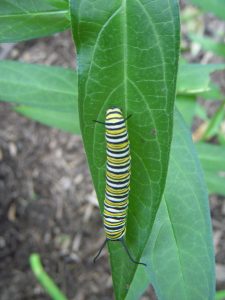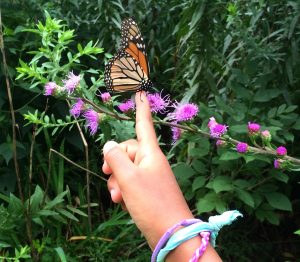
Monarch Garden Support
Let’s keep the Monarch Migration moving. Every person can do something positive to ensure its survival so that future generations can experience the sight of Monarch caterpillars and butterflies. Helping Monarchs naturally helps out the entire ecosystem. The steep decline in Monarch populations indicates that there are problems in our environment, and now is the time to take action. It’s simple and enjoyable. Not only will you be helping Monarchs and all of the other animals that depend on our garden habitats, you will also be helping yourself and the children in your lives. Research shows that we are healthier, happier, and better people when we are connected to nature. Doing something as simple as using native plants will bring nature right outside your steps. No need to travel far and wide to experience the beauty of this world and the plants and animals that create it.
5 Easy Steps to a Monarch Garden*
If you are completely new to gardening, please visit the USFWS site: How to Build a Pollinator Garden
- Plant MilkweedMonarch caterpillars can only eat milkweed. Rose Milkweed and Butterflyweed are popular choices. In a recent study, Rose Milkweed demonstrated that it was a preferred host plant for Monarchs, though often the female Monarch will prefer to lay eggs on the type of milkweed she ate as a caterpillar. We also love Common Milkweed for its beauty, resilience, and scent (perfumes the yard). It is also a productive plant, attracting dozens of pollinators and even hummingbirds. We do caution people though because it spreads rather aggressively through its rhizomes, especially if it doesn’t have much competition from other plants. Be sure to put it in an area where you won’t mind its spread. You may need to pull up its rhizomes on a regular basis. There are other lovely less well-known species of milkweeds appropriate for our climate and soils too: Purple Milkweed, Whorled Milkweed, and Prairie Milkweed (though a few of us who have tried it haven’t had any luck with it blooming.)
*Important* Be sure that you select a milkweed or milkweeds that is/are suited to your sun and soil conditions.
- Plant nectar plants, especially fall blooming onesMonarchs need fall blooming nectar plants to fuel their migration and gain weight for their hibernation.A recent study indicates that lack of fall resources is contributing to the 90% population decline. Goldenrods (do not affect allergies) and asters (not fall mums) are important nectar sources.

Great goldenrods for sunny areas are Stiff Goldenrod and Showy Goldenrod; these are beautiful though can be tall. A shorter goldenrod that also has attractive foliage is Grey Goldenrod (Solidago nemoralis). For shadier areas, there is Zig-zag Goldenrod, Blue-stemmed Goldenrod, and Elm-leaved Goldenrod. Monarchs LOVE New England Aster, so if you can, be sure to include this plant. Blue Mist is lovely for shadier areas. It spreads, so give it room and plant with some goldenrod for a beautiful blue and gold show in the fall. Liatris ligulistylis (Meadow Blazing Star) will draw Monarchs to your garden in late summer. Monarchs also love the annual Mexican Sunflower. This annual will bloom through early-mid fall. Hummingbirds will visit it too.
- Do not use any form of pesticides in your yard. Butterflies and caterpillars are sensitive to these (definitely avoid insecticides–97+% of insects are beneficial. Fungicides and herbicides could also impact them.)
- Register your garden with us and then with Monarch Waystation (we can help with the application)
*To make things even easier, you can also see our list of appropriate Monarch nectar plants that we will be carrying at our plant sale too: Monarch Garden Plant List. But if you miss our plant sale, we have a list of places where you can purchase these plants: https://westcook.wildones.org/resources/.
PS: There is momentum building for an IL Monarch decal for license plates. You can add to the momentum by placing your order for a decal: http://ilenviro.org/monarch/.
PSS: Monarch overwintering numbers reveal a 27% decline in the population from the 2015 overwintering numbers to the 2016 overwintering population. We need to continue to ramp up our efforts to conserve the Monarch migratory populations as well as the scores of less visible and charismatic animals, all of whom deserve our care and consideration of their needs and right to exist: https://phys.org/news/2017-02-monarch-butterfly-percent-mexico.htmlhttps://phys.org/news/2017-02-monarch-butterfly-percent-mexico.html
